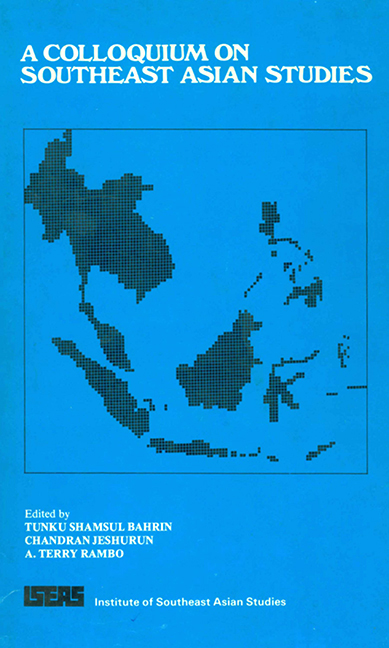Book contents
- Frontmatter
- Contents
- Foreword
- Preface
- Acknowledgements
- Introduction
- Contributors
- PART I TEACHING AND RESEARCH
- THE CONCEPTUAL THEORIES
- THE EXTRAREGIONAL EXPERIENCE
- THE REGIONAL PERSPECTIVE
- 8 Southeast Asian Studies in Indonesia
- 9 Southeast Asian Studies in Malaysia
- 10 Southeast Asian Studies in the Philippines
- 11 Southeast Asian Studies in Singapore
- 12 Southeast Asian Studies in Thailand
- THE PROBLEMS OF TEACHING AND RESEARCH
- PART II ENVIRONMENT AND DEVELOPMENT
8 - Southeast Asian Studies in Indonesia
from THE REGIONAL PERSPECTIVE
Published online by Cambridge University Press: 21 October 2015
- Frontmatter
- Contents
- Foreword
- Preface
- Acknowledgements
- Introduction
- Contributors
- PART I TEACHING AND RESEARCH
- THE CONCEPTUAL THEORIES
- THE EXTRAREGIONAL EXPERIENCE
- THE REGIONAL PERSPECTIVE
- 8 Southeast Asian Studies in Indonesia
- 9 Southeast Asian Studies in Malaysia
- 10 Southeast Asian Studies in the Philippines
- 11 Southeast Asian Studies in Singapore
- 12 Southeast Asian Studies in Thailand
- THE PROBLEMS OF TEACHING AND RESEARCH
- PART II ENVIRONMENT AND DEVELOPMENT
Summary
Academic interest in foreign languages and cultures did not begin to emerge in Indonesia until the end of 1940 when the first Faculty of Letters and Philosophy was established in Jakarta, then better known as Batavia. The faculty offered four study programmes, namely, social economic study, Indonesian language and literature, or philology, history, and ethnology (volkenkunde).
Instruction at the newly established faculty was given by five Professors, two Extraordinary Professors, and five instructors. In spite of the fact that, with the exception of two Indonesian instructors, the entire teaching staff consisted of Dutch scholars, academic interest in foreign languages and cultures gravitated towards Asian rather than European civilizations. Lectures on Dutch language and literature were given by two instructors, while lectures on Arabic, Islamic law, and Islamic institutions were the responsibility of an Extraordinary Professor as were those on the cultural history of South Asia. The cultural history of East Asia was taught by an instructor. Although attention was given to West Asia (with a focus on Islam), South Asia, and East Asia (particularly China), there was not yet any formal interest in the study of Southeast Asia.
At present, on the other hand, there is increasing awareness that academic attention should also be given to the study of Southeast Asia as a whole as well as to its individual countries. In fact, it is increasingly felt as an embarrassment that the Indonesian academic community is more familiar with faraway European and American civilizations than with the civilizations of its near neighbours.
Some of the academic interest in Southeast Asia is the natural consequence of tracing relationships and linkages between a given phenomenon in Indonesia itself with related phenomena outside the Indonesian archipelago. Interest in the study of Indonesian languages, for example, naturally leads to the necessity of studying the relationship between some of these Indonesian languages and related languages outside the boundaries of the Indonesian republic such as Malay in Malaysia and Tagalog in the Philippines.
- Type
- Chapter
- Information
- A Colloquium on Southeast Asian Studies , pp. 88 - 97Publisher: ISEAS–Yusof Ishak InstitutePrint publication year: 1981



